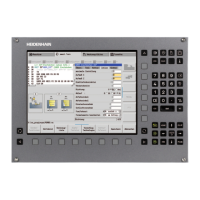1092 HEIDENHAIN Technical Manual MANUALplus 620
Speed controller
stability
measurement
Establish a connection between TNCopt and the control.
In TNCopt, select the "speed-controller pulse" function.
Load the machine parameters from the control.
Disable all filters in the speed controller.
Enter for PropGain (proportional factor of the speed controller) the value "1"
and for IntGain (integral factor of the speed controller) the value "0".
You may need to increase the starting value for IntGain (e.g. for hanging
axes).
Click the AUTO button and then the START button to start the
measurement.
Continue as described in the TNCopt User’s Manual.
Filter optimization:
During AUTO adjustment, a dominant resonance frequency might occur. If
this is the case, you should abort the AUTO adjustment, and dampen this
specific resonant frequency with a filter (band-rejection filter with 3 to 9 dB of
damping).
Repeat the AUTO adjustment and continue optimizing the filter until the
AUTO adjustment has been successfully completed.
Only repeat the filter optimization for as long as Kp clearly increases and the
rise time is approx. 3 ms.
Set as few filters as necessary.
Transfer the determined filter parameters to the control.
If TNCopt reduces the P factor continually without finding a stable value,
there might not be sufficient energy available for the speed controller's
pulse output. In this case, modify the basic settings in TNCopt in such a
way that a higher amplitude and a higher pulse width are achieved:
Settings/General/Speed Controller/Stability Measurement:
Increase gain and/or
Pulse width.
Example:
Increase the gain from 0.5 to 0.99 and the pulse width from 600 µs to
1800 µs.
The rise time is machine-dependent. The 3 ms indicated above are not a
standard value! On some types of machine, the best results might by
achieved with a rise time of 10 ms and higher.

